
 |
Visit to Drelów - Parish of Rev. Karol Wajszczuk
| Drelow was the last place, which we visited on June 2, 2002, before returning to Warsaw (see map). Rev. Karol Leonard Wajszczuk (Waldemar's uncle) served here as a parish priest from 1919 until 1941. [see: http://www.drelow.siedlce.opoka.org.pl/wajszczuk - (in polish)]. Since our "guide" and webmaster - Pawel Stefaniuk and his Family also live in Drelow, this has been already an established tradition that we and our friends must stop there. Drelow is situated in the territory of ancient settlements. Archeological excavations conducted in this area in 1990 and 1992 showed evidence of settlers living there already in ancient times as well as in the early middle ages. This area has been also strongly tied to the history of Poland and Lithuania. | ||
| The village of Drelow was most probably founded before 1525 by Jan Nassutowicz - the starost (administrator) of the Brest district. It is called Drzewlewo in documents dating back to 1602, and subsequently - Drechlow. For many years life in this area was uneasy and tulbulent, because of the adjacent border between Poland (the Crown) and (the Grand Duchy of) Lithuania.In 1648, the area suffered from the attacks of rebellious Cossacks, in 1655 from the Swedish invasion and laterfrom Russo-Cossack incursions and raids from Transylvania. The years 1874 and 1875 mark the oset of religious persecutions by the occupying Tsarist administration and of martyrdom of the Uniates, which was related to their resisting the imposition by force of Russian Orthodoxy. |
| ||
| On November 11, 1918 (the official date of the end of WW-I and of the Polish Independance Day), the retreating Germans conducted a slaughter of the civilian population and of the soldiers of the POW (Polish Military Organization); on November 18, 1918 Drelow was plundered and torched. During WW-II, very active underground resistance organizations existed in the area, which were fighting the Germans and then the oppresive communist secret police organizations after "liberation" by the Red Army. | |||
| |||
The Drelow Parish has very rich traditions of Uniate presence and activity. The first Uniate church was already erected here on November 27, 1653. Unfortunately, early in the XIX century it was struck by a lightning and it burned down. It was replaced in 1835 by a new brick church, at the expense of the Prince Konstanty Czartoryski. It stands until the present. In the XIX century, January 17, 1874 is the most important date in the history of Drelow. On this date, on orders from the Tsar, military units invaded the village. The people resisted, were fired upon and thirteen parishioners from the village and its vicinity died as martyrs defending their Faith, Church and the unity with Rome. Few hundred were wounded and many were sent to Siberia and never returned. The Uniate church was converted into an Orthodox church and the majority of the Uniates went into hiding. For many years, they were forced to conduct clandestine services and suffered persecution. Since 1919 Drelow is a Roman-Catholic parish and most of the parishioners are the descendant of the Uniates. The Tsar's Religious Tolerance Act from 1905 gave them again the religious freedom and created the possibility of returning to their old rites. However, the Uniates remembering many years of persecution, lacking their churches and pastors and distrustful of the intentions of the Russian authorities, moved wholy to the Roman-Catholic Church, whose liturgy was known and close to them. The first parish-priest of the newly erected Roman-Catholic Parish in Drelow was Rev. Karol Leonard Wajszczuk. One of the Drelow parishioners, Wladyslaw Baniosz remembers that the day of his arrival was very joyous for the Uniates: "In the morning of January 17, 1919 - it was a Friday - arrived in Drelow: the parish-priest from the St. Nicholas Parish in Miedzyrzec - Rev. Leon Wydzga and a young Rev. rector Karol Leonard Wajszczuk. The parishioners of Drelow and of the neighboring communities, who gathered in front of the church, welcomed the distinguished guests with a traditional platter of bread and salt. The Parish-priest from Miedzyrzec introduced Rev. Wajszczuk to the gathering, as the one to whom the Bishop of the Podlasie province entrusted the task of restitution of the Drelow Parish.The people were very moved and wept. Already in the first years of his work in Drelow, Rev. Karol Wajszczuk became involved in the affairs of the Uniate Martyrs. He collected many testimonies from the surviving witnesses of the bloody events of 1874 [see: Uniate testimonies - (in polish) and protocols of the persecutions - (in polish)]. For over 20 years, Rev. Karol Wajszczuk took care of the spiritual and material needs of his parishioners. The inhabitants of Drelow remember him until the present day with a particular reverence. [see: http://www.drelow.siedlce.opoka.org.pl/wajszczuk - (in polish)]. Unfortunately, the peaceful life of the Parish was interrupted by the onset of World War II. Many citizens of Drelow, who had connections with, or were members of the clandestine resistance organization "Nasze Orly" (Our Eagles), were arrested and sent to the concentration camps - only a very few returned! Rev. Karol Wajszczuk was arrested by the Gestapo in the spring of 1940, initially imprisoned in the Lublin Castle, then sent to the Sachsenhausen Concentration Camp (prisoner #25746) where he arrived on June 20, 1940. In this camp, he saved the life of another priest, Rev. Stefan Ceptowski, but he himself became gravely ill. He was then transferred and since December 14, 1940 was imprisoned in the Dachau Concentration Camp (prisoner #22572). On May 28, 1942, he was sent with the "transport of invalids" to Schloss (Castle) Hartheim. This was a known place of extermination of the sick and disabled prisoners [see: http://www.wajszczuk.v.pl/wycieczki /2001/dachau/index_eng.htm]. Since the last entry in the official documents bears the date of May 28, 1942, this date was accepted as an official date of his death. Besides the Rev. Ceptowski's testimony [see: http://www.drelow.siedlce.opoka.org.pl/ wajszczuk/swiadek.htm - (in polish)], the details of his imprisonment and circumstances of his death are not known. In the meantime bad things were happening in the Parish of Drelow. After Rev. Wajszczuk's arrest, on the orders from the county executive (Starost) in Radzyn dated May 25, 1940 - the church and the presbytery were taken over by the Ukrainian (Orthodox) nationalists and in exchange the chapel in Horodek was given to the Polish parishioners [see: http://www.drelow.siedlce.opoka. org.pl/horodek/index.html - (in polish)]. Rev. Leon Gliszczynski, who was substituting as a parish priest in Drelow, obtained permission from the Starost to remove the organ asembly (they are not being used in the Orthodox liturgy and churches).They were removed in September of 1940 and the organist Antoni Patkowski, assisted by the parishioners, trasported them to the village of Przechodziska, where they were stored in the house of Bazyli and Katarzyna Olesiejuk. The ceremonial canopy, church banners, liturgical vestments, utensils and other cult accessories were taken by Rev. Gliszczynski to Horodek. | |||
 Church interior in 1940 - after takover and during conversion into an Orthodoxhouse of worship (cerkiew) | 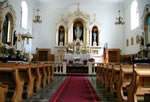 Church interior at present - 2000 | ||
The history of this church in Drelow can serve as a typical example of religious (and political) upheavals in this part of Poland over the centuries, more so in the 19th and 20th centuries. Initially built in the 17th century (at the time of the Union between Poland and Lithuania - the so-called "Republic of the Two Nations") to serve the needs of the Uniates, it was converted to the Orthodox place of worship in 1884 (during the period of the Partitioning of Poland) after abolishing of the Union by the Tsar, which was also accompanied by religious persecution. After the 1905 Tsar's Decree restoring the religious freedom and then finally after regaining by Poland in 1918 its independance, it became a Roman-Catholic church in 1919 and the site of a Parish. It was taken away again from the Catholics in 1940 (shortly after the onset of WW-II) and given by the German occupying authorities to the Ukrainian Orthodox, when it was severily damaged during conversion. Finally after the war it was again taken over by a Roman-Catholic Parish. After the end of the war, symbolic urns with the ashes of Rev. Karol Wajszczuk and of his parishioners were brought from variuos concentration camps and buried in the cemetery in Drelow in a specially constructed tomb [see]. In May of 1997, a memorial plaque was unvailed in the Parish Church in Drelow honoring Rev. Wajszczuk [see]. | |||
By now it is almost a custom that while in Drelow, we visit Pawel and his Family in their beautiful residence and garden, where we are fed and entertained. This was also the case this time, when our guests and friends had an opportunity to get familiar with the famous Polish hospitality and excellent food (and beverages! - I felt sorry for the driver - there is a "zero"-tolerance in Poland for the consumption of "beverages" by the driver, while on the road)! The evening progressed very fast at a full table and with lively conversations, exchanging jokes and story-telling by the charming hosts. We returned to Warsaw late at night!
click on the picture to enlarge
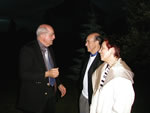 |  | 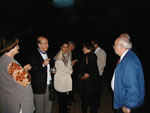 | |
 | 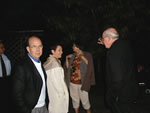 | 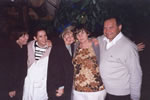 | |
 The Stefaniuks: Father, Mother and son Pawel with two Carmens | 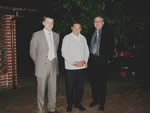 from left: Pawel Stefaniuk, Franciszek J. Stefaniuk (father) and Richard Scofield | ||